A Project of the Hudson River Estuary Program
Compiled and edited by Tom Lake, Consulting Naturalist
Love Our NY Lands
State Lands Belong to All of Us
All New Yorkers and visitors should be able to access, enjoy, and feel welcome on state lands. These lands belong to all of us, our families, and our neighbors. While enjoying these shared spaces, be respectful of other visitors. Share trails, treat people with kindness, and leave things as you found them for others to enjoy. All of us have a responsibility to protect State lands for future generations. For more information, visit DEC's website.
Overview
This was a warm, humid, dry, and sleepy summer week. Our wildlife reports had great variety from black bears to uncommon shorebirds to bottlenose dolphins. The onslaught of the invasive spotted lanternfly continued.
Highlight of the Week
 8/24 – Ulster County, HRM 102: I drove up West Saugerties Mountain Road today and had my first black bear sighting of the year. The small bear — three feet long — clambered up from The Clove and crossed the road in front of my car. It scampered on up a near-vertical bank and was out of sight in less than thirty seconds. I guessed its mother was up ahead of him; it was too small to be roaming alone. Farther up the road, a massive, venerable porcupine made a road-side appearance. I was not about to tangle with that bristled tail. I felt so privileged to see these two signature mountain native species in the space of a few minutes. (Photo of porcupine courtesy of Mario Meier) 8/24 – Ulster County, HRM 102: I drove up West Saugerties Mountain Road today and had my first black bear sighting of the year. The small bear — three feet long — clambered up from The Clove and crossed the road in front of my car. It scampered on up a near-vertical bank and was out of sight in less than thirty seconds. I guessed its mother was up ahead of him; it was too small to be roaming alone. Farther up the road, a massive, venerable porcupine made a road-side appearance. I was not about to tangle with that bristled tail. I felt so privileged to see these two signature mountain native species in the space of a few minutes. (Photo of porcupine courtesy of Mario Meier)
- Mario Meier
[The north American porcupine (Erethizon dorsatum) is a New World Porcupine and is indigenous to North America and northern South America. They are found in New England, the upper Midwest, western United States, and most of Canada. The two biggest populations in New York are in the Adirondacks and the Catskills. They are the second-largest rodent in the U.S — only beavers are bigger — ranging from 24-40-inches-long and 10-35 pounds in weight.
The North American porcupine is also known as quill-pig, hedgehog, and porky. Their back, sides, and tail are covered with as many as 30,000 stiff, needle-like, finely barbed hairs (quills) for defense. The quills are hollow and barbed, thus making them painful to remove. Porcupines cannot “shoot” their quills, but the quills come out quite easily on contact. Their main predator is the fisher, an animal that often successfully manages to flip them over and attack the porcupine’s underside (Uldis Roze, 2009).
Natural History Entries
8/20 – Hudson River Estuary: The final tallies for the 11th annual Great Hudson River Fish Count have arrived. The annual event was held at eleven sites, from Peebles Island in Saratoga County (river mile 158) downriver to New York City at the Brooklyn Bridge Park Conservancy in the East River. The Fish Count’s focus was on numbers of fish, but even more, we welcomed the opportunity to introduce many people to the incredible diversity of Hudson River aquatic life.
For the 2022 Fish Count, 535 people counted 1,374 fish of 38 different species. Sites used a variety of methods and gear, from seines to rod and reel, to electro-fishing, and otter trawling.
- Benjamin Harris
8/20 – Saugerties, HRM 102: Just after high tide this morning, a seal surfaced to the north of the lighthouse. I noticed a flipper tag as it approached. Since the tide was up, there was water between the lighthouse and the adjacent island deck, so the seal was able to swim under the bridge in three feet of water. He did the same thing two days ago much to the delight of our visitors.
- Patrick Landewe
[As of today, the quasi-residence in freshwater at Saugerties of this tagged male harbor seal, 110 miles from the sea, was at 1,010 days. Tom Lake]
 8/20 – Piermont, HRM 25: We had baby blue crab mania today seining on the north side of the Piermont Pier. During our weekly Science Saturday event, we caught 86 baby blue crabs (young-of-season) in just two hauls. Their sizes ranged from only a few millimeters (mm) to about 15 mm in length. These blue crabs still have a long way to go before they develop their characteristic cerulean blue color. At this early life stage, their green carapace helps them blend into the bottom of the river, thus providing concealment from predators. We were heartened by the numbers; it is always exciting to see evidence of successful reproduction in our area. Salinity was 10.0 parts-per-thousand (ppt). (Photo of blue crab courtesy of Tom Lake) 8/20 – Piermont, HRM 25: We had baby blue crab mania today seining on the north side of the Piermont Pier. During our weekly Science Saturday event, we caught 86 baby blue crabs (young-of-season) in just two hauls. Their sizes ranged from only a few millimeters (mm) to about 15 mm in length. These blue crabs still have a long way to go before they develop their characteristic cerulean blue color. At this early life stage, their green carapace helps them blend into the bottom of the river, thus providing concealment from predators. We were heartened by the numbers; it is always exciting to see evidence of successful reproduction in our area. Salinity was 10.0 parts-per-thousand (ppt). (Photo of blue crab courtesy of Tom Lake)
- Marisa Annunziato
[Note: One-inch equals 25.4 millimeters (mm)]
8/20 – Yonkers, HRM 18: The staff at the Sarah Lawrence Center for the Urban River at Beczak did some public seining today in the last of the down tide. The river was 78 degrees Fahrenheit (F), the salinity was steady at 12.0 ppt, and the dissolved oxygen level was 8.6 parts-per-million (ppm).
Although we caught small striped bass, mummichogs, blue crabs, moon jellyfish, and grass shrimp, the highlight was a 90 mm immature tautog or blackfish (Tautoga onitis). This was the first tautog caught at Beczak since 2005.
- Katie Lamboy
[Immature tautog have become uncommon upriver from the Upper Bay of New York Harbor in recent times. However, but twenty years ago it was not uncommon to catch young-of-year blackfish in our seine as far upriver as Croton Point. On 9-11, Chris Letts and I, during a school program for second-graders, seined half a dozen tautog at Croton Point. All the while, as a backdrop, Manhattan was being attacked. Tom Lake]
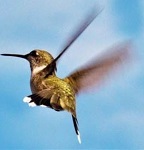 8/21 – Greene County, 113: Our smallest breeding bird, and perhaps one of our most beautiful, is the ruby-throated hummingbird (Archilochus colubris). My neighbor in the Catskills has a hummingbird feeder (especially appreciated by birds in drought conditions). This unique tiny bird has always intrigued me, and I took the chance to lie unobtrusively on the ground near the feeder and watched with fascination as the air above me hummed with aerobatic displays. Approaching birds were just streaks cruising in at over 35 miles-per-hour (mph) — they are capable of diving over 60 mph. All at once they miraculously decelerate to a hovering position to feed on flower nectar or a sip from the feeder. Then they accelerate away in a blur. 8/21 – Greene County, 113: Our smallest breeding bird, and perhaps one of our most beautiful, is the ruby-throated hummingbird (Archilochus colubris). My neighbor in the Catskills has a hummingbird feeder (especially appreciated by birds in drought conditions). This unique tiny bird has always intrigued me, and I took the chance to lie unobtrusively on the ground near the feeder and watched with fascination as the air above me hummed with aerobatic displays. Approaching birds were just streaks cruising in at over 35 miles-per-hour (mph) — they are capable of diving over 60 mph. All at once they miraculously decelerate to a hovering position to feed on flower nectar or a sip from the feeder. Then they accelerate away in a blur.
For a half-hour, I watched a very minute and territorial bird engage in combat twittering as it flitted with others at the feeder. The silky emerald green of their dorsal feathers shimmered, and the delicate long curved bill gave the birds exceptional grace. Most of the ones I saw were ruby-throated females or immatures. The occasional male exhibited the deep ruby-throated bib below its neck band.
These hummingbirds would soon migrate, and they seemed in a frenzy to tank up for their departure. A difficult to believe phenomenon is the hummingbird’s ability to fly 500 miles nonstop over the Gulf of Mexico to their Central American wintering grounds. This is a delicate and intense speedster to witness up close. (Photo of ruby-throated hummingbird courtesy of Mario Meier)
- Mario Meier
[Ruby-throated hummingbirds use nectar for their energy needs but can often eat more than 1,000 insects per day. Beating at a rate of 53 times per second (over 3,000 beats per minute), their tiny wings are just a blur creating the audible “humming” buzz. They can fly upside down as well as backwards and their heart rate is 1,200 beats per minute. They build tiny, camouflaged nests of lichens, spider webs, and plant fibers and lay eggs weighing little more than a gram. Mario Meier]
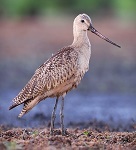 8/22 – Town of Warwick, HRM 41: Bradley White located a marbled godwit (first seen by Linda Scrima) on the west side of the Wallkill River National Wildlife Refuge Liberty Marsh Loop. Maria Loukeris reported the bird on the Mearns Bird Club app. 8/22 – Town of Warwick, HRM 41: Bradley White located a marbled godwit (first seen by Linda Scrima) on the west side of the Wallkill River National Wildlife Refuge Liberty Marsh Loop. Maria Loukeris reported the bird on the Mearns Bird Club app.
When I arrived, there was no sign of the bird. Fortunately, I ran into Ronnie DiLorenzo who told me the bird had relocated to the southernmost pond in the loop. This time the bird was not only present, but not too far out. This is the second straight Monday where I got a fabulous shorebird – it is a good cure for a bad case of the Mondays! (Photo of marbled godwit courtesy of Kyle Knapp)
- Matt Zeitler
[The 335-acre Liberty Marsh is part of the U.S. Fish and Wildlife Service’s Wallkill River National Wildlife Refuge Complex, adjacent to and near the headwaters of the Wallkill River.
8/22 – Manhattan, HRM 1-2: Our Hudson River Park staff checked our research gear (pots and traps) that we deploy off Piers 40 and 26 in the Hudson River as part of our ongoing fish ecology survey. At Pier 26, we found two juvenile tautog (200, 249 mm). A blue crab clinging to a crab pot at Pier 40 fell off as we lifted the gear. Three young-of-year fishes, two black sea bass (50 mm) and one oyster toadfish (35 mm), were in our minnow traps.
- Zoe Kim
[The standard research measurement for blue crabs (millimeters-mm) is point-to-point, laterally, across their carapace.]
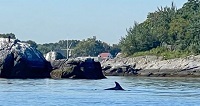 8/23 – Bronx, New York City: We spotted a bottlenose dolphin in the East River today a half-mile east of City Island. (Photo of bottlenose dolphin courtesy of Sally Connolly) 8/23 – Bronx, New York City: We spotted a bottlenose dolphin in the East River today a half-mile east of City Island. (Photo of bottlenose dolphin courtesy of Sally Connolly)
- Sally Connolly
[The list of Hudson River Estuary marine mammals documented in the Hudson River Almanac across the last 28 years includes:
- Hooded seal (Cystophora cristata)
- Gray seal (Halichoerus grypus)
- Harp seal (Pagophilus groenlandicus)
- Harbor seal (Phoca vitulina)
- Short-beaked common dolphins (Delphinus delphis)
- Risso’s dolphin (Grampus griseus)
- Common (bottlenose) dolphin (Tursiops truncatus)
- Common (harbor) porpoise (Phocoena phocoena)
- Florida manatee (2006) (Trichechus manatus latirostris)
- Minke whale (2007) (Balaenoptera acutorostrata)
- humpback whale (2016) (Megaptera novaeangliae)
 8/23 – Manhattan, HRM 1-2: Our Hudson River Park staff checked our research gear (pots and traps) that we deploy off Piers 40 and 26 in the Hudson River as part of our ongoing fish ecology survey. We had a busy day at Pier 26! 8/23 – Manhattan, HRM 1-2: Our Hudson River Park staff checked our research gear (pots and traps) that we deploy off Piers 40 and 26 in the Hudson River as part of our ongoing fish ecology survey. We had a busy day at Pier 26!
A crab pot had caught an adult oyster toadfish (230 mm) and two adult tautog/blackfish (270, 336 mm). Three bruisers! In a second crab pot, we found two male young-of-season blue crabs (10, 16 mm) and yet another adult tautog (260 mm).
This was also exciting day at Pier 40. We found a male and a female blue crab in a crab pot. Both were young-of-season, about 25 mm, and were small enough to escape if they tried. Other crab pots held a tautog (155 mm) and a male blue crab with no claws. The crab had likely lost its claws in a territorial struggle with another crab. If he can avoid predators for a couple of moults, he may regenerate new claws. (Photo of blue crab pot courtesy of Tom Lake)
- Zoe Kim
8/24 – Hook Mountain, HRM 31: Across almost five hours, we counted three south-migrating American kestrels at the Hook Mountain Hawkwatch today. Two bald eagles, an osprey, and several red-tailed hawks were also around but were likely not migrating. Non-raptor migrants included two ruby-throated hummingbirds.
- Steve Sachs, Raimund Miller
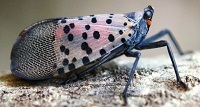 8/24 – Manhattan, HRM 1: Today there were literally hundreds of spotted lanternflies on the plaza at 28 Liberty Street where I work. The granite stone on the plaza is very similar to the lanternfly's closed wing coloration, so they blend in well. I wondered if that has anything to do with their attraction to the location. The head of security at our building said they are attempting to control them, with limited success. He told me they sweep up a thousand of them every day, and that they are all over lower Manhattan. Very “plague-ish.” (Photo of spotted lanternfly courtesy of Garrett Ellison) 8/24 – Manhattan, HRM 1: Today there were literally hundreds of spotted lanternflies on the plaza at 28 Liberty Street where I work. The granite stone on the plaza is very similar to the lanternfly's closed wing coloration, so they blend in well. I wondered if that has anything to do with their attraction to the location. The head of security at our building said they are attempting to control them, with limited success. He told me they sweep up a thousand of them every day, and that they are all over lower Manhattan. Very “plague-ish.” (Photo of spotted lanternfly courtesy of Garrett Ellison)
- Hugh McLean
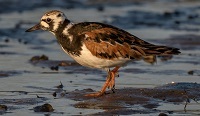 8/25 – New Windsor, HRM 58: Bruce Nott contacted me to let me know he had a ruddy turnstone in sight at Moodna Creek on a sandbar in Newburgh Bay. I approached in my kayak and the turnstone hung in there for me, and the lighting was nice, so it made for yet another fabulous shore-birding experience this season. The ruddy turnstone was species number 270 for me in Orange County. As a bonus, there were seven Caspian terns also present on the sandbar, making a racket and being generally beautiful and entertaining. (Photo of ruddy turnstone courtesy of Matt Zeitler) 8/25 – New Windsor, HRM 58: Bruce Nott contacted me to let me know he had a ruddy turnstone in sight at Moodna Creek on a sandbar in Newburgh Bay. I approached in my kayak and the turnstone hung in there for me, and the lighting was nice, so it made for yet another fabulous shore-birding experience this season. The ruddy turnstone was species number 270 for me in Orange County. As a bonus, there were seven Caspian terns also present on the sandbar, making a racket and being generally beautiful and entertaining. (Photo of ruddy turnstone courtesy of Matt Zeitler)
- Matt Zeitler
8/25 – Bedford, HRM 35: Among the eleven south-migrating raptors today at the Bedford Audubon Chestnut Ridge Hawkwatch, broad-winged hawk was high count with four; osprey was next with three. Non-raptor migrants included five ruby-throated hummingbirds, four monarch butterflies, and 46 chimney swifts. With drought conditions, quite a few trees and shrubs in the area were showing the effects with brown-yellowing foliage.
- Richard Aracil
 8/25 – Manhattan, HRM 13.5: At midday in Inwood Hill Park, the air temperature was 90 degrees; with the sky clear and no wind, the heat was oppressive. In the little strip of salt marsh along the inlet of Spuyten Duyvil Creek, the two grasses called salt-marsh grass and salt reed-grass (Spartina alterniflora and S. cynosuroides) had their tiny flowers. Bouncing Bet still had a few flowers but was now almost completely hidden by mugwort and porcelain berry. 8/25 – Manhattan, HRM 13.5: At midday in Inwood Hill Park, the air temperature was 90 degrees; with the sky clear and no wind, the heat was oppressive. In the little strip of salt marsh along the inlet of Spuyten Duyvil Creek, the two grasses called salt-marsh grass and salt reed-grass (Spartina alterniflora and S. cynosuroides) had their tiny flowers. Bouncing Bet still had a few flowers but was now almost completely hidden by mugwort and porcelain berry.
Otherwise, the marsh was between seasons. Most plants, such as marsh elder (Iva frutescens), had finished blooming. Groundsel bush (Baccharis halimifolia) was budding, as was yam-leaved clematis (Clematis terniflora).
The tide was low, and the inlet was a mud flat with just one little rill meandering through toward the outlet. On a few small rocks a great egret and a great blue heron stood a few feet apart, just looking; there was almost no open water, and it was too hot to fish anyway. (Photo of spartina cynosuroides courtesy of Will Cook)
- Thomas Shoesmith
8/26 – Bedford, HRM 35: Among the seven south-migrating raptors today at the Bedford Audubon Chestnut Ridge Hawkwatch, broad-winged hawk was high count with three; osprey was next with two. Non-raptor migrants included three ruby-throated hummingbirds, one monarch butterfly, 35 chimney swifts, a solitary sandpiper flyover, and one spotted lanternfly, the latter probably migrating north.
- Richard Aracil
** Fish of the Week **
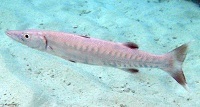 8/26 – Hudson River Watershed: Week 184 for Fish-of-the-Week is the guaguanche (Sphyraena guachancho), number 200 (of 236) on our watershed list of fishes. If you would like a copy of our list, e-mail trlake7@aol.com. 8/26 – Hudson River Watershed: Week 184 for Fish-of-the-Week is the guaguanche (Sphyraena guachancho), number 200 (of 236) on our watershed list of fishes. If you would like a copy of our list, e-mail trlake7@aol.com.
The guaguanche is closely related (same genus) to last week’s barracuda, the northern sennet (S. borealis). Both are much smaller versions of the great barracuda (S. barracuda) that can get to be more than six-feet-long. The presence of our two smaller barracudas in the estuary has been tenuous at best, with fewer than five records of each, all small immatures. Briggs and Waldman (2002) call them rare in the New York Bight. In the estuary, we have one record from 1987 (142 mm) from Indian Point (river mile 42).
Like the northern sennet, guaguanche are found in coastal waters from Cape Cod to Florida and, like all barracuda, are a toothy predator. Guaguanche are a bit larger than northern sennet, reaching 24-inches. Both of our small barracudas are considered uncommon to rare north of Chesapeake Bay. (Photo of guaguanche courtesy of Ross Robertson)
- Tom Lake
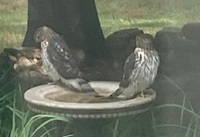 8/26 – Westchester County, HRM 45: We have a hawk family of five in our yard in Katonah, a full open acre bordered by seven oaks and a dozen tall white pines where they hang out. All four sides have tremendous, tall-tree cover. They occupy a wooded swath of maybe 3/4 of a mile long by almost half a mile wide. 8/26 – Westchester County, HRM 45: We have a hawk family of five in our yard in Katonah, a full open acre bordered by seven oaks and a dozen tall white pines where they hang out. All four sides have tremendous, tall-tree cover. They occupy a wooded swath of maybe 3/4 of a mile long by almost half a mile wide.
We have two birdbaths, both early Covid installations. It seemed that it took forever, but the songbirds showed up eventually in 2020 and then throughout 2021. We do not feed the birds in summer save for hummingbirds, and now a downy woodpecker who likes the sugar water. But our usual songbirds bathing in our two baths have disappeared. Chipmunks are few to none.
Even though the hawks are here, I’d still like to continue to make our yard a haven for songbirds that continue to be conspicuously absent. We figured we’d leave the hawks alone because they only come together in the early evening, and we’ve seen no signs of hawk kill so far. But if they continue to displace our other wildlife, we will consider broadcasting loud owl hoots from our outdoor speakers hoping they will find another area to hunt. (Photo of cooper's hawks courtesy of Tom Connor)
- Tom Connor

Summer 2022 Natural History Programs and Events
Come Canoeing with the National Estuarine Research Reserve
Free public canoe program in the tidal marshes of the Hudson River estuary. Learn about the wildlife and dynamic system of the tidal wetlands. Information and registration link:
https://2022-nysdec-canoeprogram.eventbrite.com
September 18, 11:00 a.m. 22nd Hudson River Ramble
Hudson Highlands State Park
Little Stony Point, Route 9D, Cold Spring
Hudson River Education
Teachers and students will enjoy our new Hudson River K-12 Unit of Study. This carefully curated group of lesson plans, arranged by topic and/or grade, brings together great learning tools developed by the DEC and dozens of estuary partners.
Hudson River Miles
The Hudson is measured north from Hudson River Mile 0 at the Battery at the southern tip of Manhattan. The George Washington Bridge is at HRM 12, the Tappan Zee 28, Bear Mountain 47, Beacon-Newburgh 62, Mid-Hudson 75, Kingston-Rhinecliff 95, Rip Van Winkle 114, and the Federal Dam at Troy, the head of tidewater, at 153. The tidal section of the Hudson constitutes a bit less than half the total distance – 315 miles – from Lake Tear of the Clouds to the Battery. Entries from points east and west in the watershed reference the corresponding river mile on the mainstem.
To Contribute Your Observations or to Subscribe
The Hudson River Almanac is compiled and edited by Tom Lake and emailed weekly by DEC's Hudson River Estuary Program. Share your observations by e-mailing them to trlake7@aol.com. To subscribe to the Almanac (or to unsubscribe), use the links on DEC's Hudson River Almanac or DEC Delivers web pages.
Useful Links
National Oceanic and Atmospheric Administration online tide and tidal current predictions are invaluable when planning Hudson River field trips. For real-time information on Hudson River tides, weather, and water conditions from sixteen monitoring stations, visit the Hudson River Environmental Conditions Observing System website.
DEC's Smartphone app for iPhone and Android is now available at New York Fishing, Hunting & Wildlife App. The HuntFishNY app, includes the new Tackle Box feature, which provides a one-stop location for nearly all State fishing regulations, waterbodies, State-operated fishing access sites, stocking information, and other useful features like photos to help identify fish likely found in a certain river, lake, or stream. Tackle Box allows users to search for waterbodies by name or by panning and zooming. In addition, the new 'navigate' feature gives users driving directions to the boating access site of their choice. The Tackle Box also includes an offline feature that allows anglers to use it when cell service is not available.
|


 8/24 – Ulster County, HRM 102: I drove up West Saugerties Mountain Road today and had my first black bear sighting of the year. The small bear — three feet long — clambered up from The Clove and crossed the road in front of my car. It scampered on up a near-vertical bank and was out of sight in less than thirty seconds. I guessed its mother was up ahead of him; it was too small to be roaming alone. Farther up the road, a massive, venerable porcupine made a road-side appearance. I was not about to tangle with that bristled tail. I felt so privileged to see these two signature mountain native species in the space of a few minutes. (Photo of porcupine courtesy of Mario Meier)
8/24 – Ulster County, HRM 102: I drove up West Saugerties Mountain Road today and had my first black bear sighting of the year. The small bear — three feet long — clambered up from The Clove and crossed the road in front of my car. It scampered on up a near-vertical bank and was out of sight in less than thirty seconds. I guessed its mother was up ahead of him; it was too small to be roaming alone. Farther up the road, a massive, venerable porcupine made a road-side appearance. I was not about to tangle with that bristled tail. I felt so privileged to see these two signature mountain native species in the space of a few minutes. (Photo of porcupine courtesy of Mario Meier) 8/20 – Piermont, HRM 25: We had baby blue crab mania today seining on the north side of the Piermont Pier. During our weekly Science Saturday event, we caught 86 baby blue crabs (young-of-season) in just two hauls. Their sizes ranged from only a few millimeters (mm) to about 15 mm in length. These blue crabs still have a long way to go before they develop their characteristic cerulean blue color. At this early life stage, their green carapace helps them blend into the bottom of the river, thus providing concealment from predators. We were heartened by the numbers; it is always exciting to see evidence of successful reproduction in our area. Salinity was 10.0 parts-per-thousand (ppt). (Photo of blue crab courtesy of Tom Lake)
8/20 – Piermont, HRM 25: We had baby blue crab mania today seining on the north side of the Piermont Pier. During our weekly Science Saturday event, we caught 86 baby blue crabs (young-of-season) in just two hauls. Their sizes ranged from only a few millimeters (mm) to about 15 mm in length. These blue crabs still have a long way to go before they develop their characteristic cerulean blue color. At this early life stage, their green carapace helps them blend into the bottom of the river, thus providing concealment from predators. We were heartened by the numbers; it is always exciting to see evidence of successful reproduction in our area. Salinity was 10.0 parts-per-thousand (ppt). (Photo of blue crab courtesy of Tom Lake) 8/21 – Greene County, 113: Our smallest breeding bird, and perhaps one of our most beautiful, is the ruby-throated hummingbird (Archilochus colubris). My neighbor in the Catskills has a hummingbird feeder (especially appreciated by birds in drought conditions). This unique tiny bird has always intrigued me, and I took the chance to lie unobtrusively on the ground near the feeder and watched with fascination as the air above me hummed with aerobatic displays. Approaching birds were just streaks cruising in at over 35 miles-per-hour (mph) — they are capable of diving over 60 mph. All at once they miraculously decelerate to a hovering position to feed on flower nectar or a sip from the feeder. Then they accelerate away in a blur.
8/21 – Greene County, 113: Our smallest breeding bird, and perhaps one of our most beautiful, is the ruby-throated hummingbird (Archilochus colubris). My neighbor in the Catskills has a hummingbird feeder (especially appreciated by birds in drought conditions). This unique tiny bird has always intrigued me, and I took the chance to lie unobtrusively on the ground near the feeder and watched with fascination as the air above me hummed with aerobatic displays. Approaching birds were just streaks cruising in at over 35 miles-per-hour (mph) — they are capable of diving over 60 mph. All at once they miraculously decelerate to a hovering position to feed on flower nectar or a sip from the feeder. Then they accelerate away in a blur. 8/22 – Town of Warwick, HRM 41: Bradley White located a marbled godwit (first seen by Linda Scrima) on the west side of the Wallkill River National Wildlife Refuge Liberty Marsh Loop. Maria Loukeris reported the bird on the Mearns Bird Club app.
8/22 – Town of Warwick, HRM 41: Bradley White located a marbled godwit (first seen by Linda Scrima) on the west side of the Wallkill River National Wildlife Refuge Liberty Marsh Loop. Maria Loukeris reported the bird on the Mearns Bird Club app. 8/23 – Bronx, New York City: We spotted a bottlenose dolphin in the East River today a half-mile east of City Island. (Photo of bottlenose dolphin courtesy of Sally Connolly)
8/23 – Bronx, New York City: We spotted a bottlenose dolphin in the East River today a half-mile east of City Island. (Photo of bottlenose dolphin courtesy of Sally Connolly) 8/23 – Manhattan, HRM 1-2: Our Hudson River Park staff checked our research gear (pots and traps) that we deploy off Piers 40 and 26 in the Hudson River as part of our ongoing fish ecology survey. We had a busy day at Pier 26!
8/23 – Manhattan, HRM 1-2: Our Hudson River Park staff checked our research gear (pots and traps) that we deploy off Piers 40 and 26 in the Hudson River as part of our ongoing fish ecology survey. We had a busy day at Pier 26! 8/24 – Manhattan, HRM 1: Today there were literally hundreds of spotted lanternflies on the plaza at 28 Liberty Street where I work. The granite stone on the plaza is very similar to the lanternfly's closed wing coloration, so they blend in well. I wondered if that has anything to do with their attraction to the location. The head of security at our building said they are attempting to control them, with limited success. He told me they sweep up a thousand of them every day, and that they are all over lower Manhattan. Very “plague-ish.” (Photo of spotted lanternfly courtesy of Garrett Ellison)
8/24 – Manhattan, HRM 1: Today there were literally hundreds of spotted lanternflies on the plaza at 28 Liberty Street where I work. The granite stone on the plaza is very similar to the lanternfly's closed wing coloration, so they blend in well. I wondered if that has anything to do with their attraction to the location. The head of security at our building said they are attempting to control them, with limited success. He told me they sweep up a thousand of them every day, and that they are all over lower Manhattan. Very “plague-ish.” (Photo of spotted lanternfly courtesy of Garrett Ellison) 8/25 – New Windsor, HRM 58: Bruce Nott contacted me to let me know he had a ruddy turnstone in sight at Moodna Creek on a sandbar in Newburgh Bay. I approached in my kayak and the turnstone hung in there for me, and the lighting was nice, so it made for yet another fabulous shore-birding experience this season. The ruddy turnstone was species number 270 for me in Orange County. As a bonus, there were seven Caspian terns also present on the sandbar, making a racket and being generally beautiful and entertaining. (Photo of ruddy turnstone courtesy of Matt Zeitler)
8/25 – New Windsor, HRM 58: Bruce Nott contacted me to let me know he had a ruddy turnstone in sight at Moodna Creek on a sandbar in Newburgh Bay. I approached in my kayak and the turnstone hung in there for me, and the lighting was nice, so it made for yet another fabulous shore-birding experience this season. The ruddy turnstone was species number 270 for me in Orange County. As a bonus, there were seven Caspian terns also present on the sandbar, making a racket and being generally beautiful and entertaining. (Photo of ruddy turnstone courtesy of Matt Zeitler) 8/25 – Manhattan, HRM 13.5: At midday in Inwood Hill Park, the air temperature was 90 degrees; with the sky clear and no wind, the heat was oppressive. In the little strip of salt marsh along the inlet of Spuyten Duyvil Creek, the two grasses called salt-marsh grass and salt reed-grass (Spartina alterniflora and S. cynosuroides) had their tiny flowers. Bouncing Bet still had a few flowers but was now almost completely hidden by mugwort and porcelain berry.
8/25 – Manhattan, HRM 13.5: At midday in Inwood Hill Park, the air temperature was 90 degrees; with the sky clear and no wind, the heat was oppressive. In the little strip of salt marsh along the inlet of Spuyten Duyvil Creek, the two grasses called salt-marsh grass and salt reed-grass (Spartina alterniflora and S. cynosuroides) had their tiny flowers. Bouncing Bet still had a few flowers but was now almost completely hidden by mugwort and porcelain berry. 8/26 – Hudson River Watershed: Week 184 for Fish-of-the-Week is the guaguanche (Sphyraena guachancho), number 200 (of 236) on our watershed list of fishes. If you would like a copy of our list, e-mail
8/26 – Hudson River Watershed: Week 184 for Fish-of-the-Week is the guaguanche (Sphyraena guachancho), number 200 (of 236) on our watershed list of fishes. If you would like a copy of our list, e-mail  8/26 – Westchester County, HRM 45: We have a hawk family of five in our yard in Katonah, a full open acre bordered by seven oaks and a dozen tall white pines where they hang out. All four sides have tremendous, tall-tree cover. They occupy a wooded swath of maybe 3/4 of a mile long by almost half a mile wide.
8/26 – Westchester County, HRM 45: We have a hawk family of five in our yard in Katonah, a full open acre bordered by seven oaks and a dozen tall white pines where they hang out. All four sides have tremendous, tall-tree cover. They occupy a wooded swath of maybe 3/4 of a mile long by almost half a mile wide.